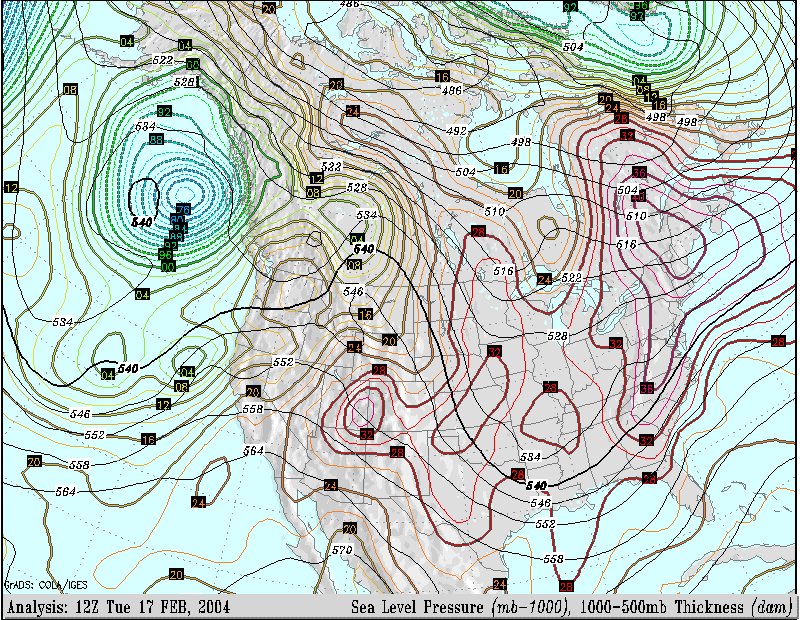| ATS
652 - Synoptic
Meteorology
 This
class will provide a balance between theory and practical applications
toward describing synoptic-scale phenomena, including air masses,
frontal systems, cyclones, anti-cyclones, tropical cyclones and
associated mesoscale components. Heavy emphasis is placed on building
an understanding of potential vorticity theory and understanding
synoptic weather via isentropic analysis. This will be accomplished
where possible through use of satellite data, NWP models, and workstations
that involve remote sensing. In-class instruction will be complimented
by applications involving hands-on weather interpretation, map and
forecast discussions, forecast presentations, and case study analysis.
Use of National Weather Service COMET web-based modules will enhance
the instruction. The class will highlight aspects of synoptic scale
weather unique to the southeastern U.S., given the combined tropical
and midlatiude influences. An AMS-style Conference finalizes the
class, comprised of student presentations. This
class will provide a balance between theory and practical applications
toward describing synoptic-scale phenomena, including air masses,
frontal systems, cyclones, anti-cyclones, tropical cyclones and
associated mesoscale components. Heavy emphasis is placed on building
an understanding of potential vorticity theory and understanding
synoptic weather via isentropic analysis. This will be accomplished
where possible through use of satellite data, NWP models, and workstations
that involve remote sensing. In-class instruction will be complimented
by applications involving hands-on weather interpretation, map and
forecast discussions, forecast presentations, and case study analysis.
Use of National Weather Service COMET web-based modules will enhance
the instruction. The class will highlight aspects of synoptic scale
weather unique to the southeastern U.S., given the combined tropical
and midlatiude influences. An AMS-style Conference finalizes the
class, comprised of student presentations.
The goal of the course is to provide students in graduate level
atmospheric science a broad background into synoptic meteorology
at a level above undergraduate level material. The course therefore
assumes a strong familiarity with atmospheric thermodynamics (ATS
541) and dynamics (ATS 551) so that this course's material can grow
from these basic concepts. It is very much encouraged that students
understand or be prepared to learn simple programming skills, as
required for several homework assignments.
Course Syllabus
1. Overview:
a) Definitions & Units
b) Influences of atmospheric moisture
c) The role of the mesoscale?
2. Kinematics of the Flow:
a) Divergence, vorticity & deformation; Trajectories
b) Helmholtz partitioning of wind field
c) Vorticity & potential vorticity
3. Balanced Flow:
a) Geostrophic flow definition
b) Other balance criteria
c) Geostrophic adjustment (shallow water system)
4. Quasi-Geostrophic Dynamics & Diagnostics:
a) Overview of Pressure tendency
b) Overview of QG-omega & QG-vorticity equations
c) QG potential vorticity; Q-vectors
5. Vertical Variation of Wind:
a) Thermal wind, vertical wind shear
b) Thermal wind balance
c) Advection
6. Midlatitude Cyclones:
a) Rossby waves; Flow regimes and circulation
b) Vertical structure of waves & Development
c) Cylogenesis, cyclone movement; Anticyclones
d) Three-dimensional flow & precipitation
e) Isentropic flow
7. Fronts and Jet Streams:
a) Frontogenesis (diagnosing)
b) Semi-geostrophic theory
c) Jet streaks
8. Instability & Convection:
a) Measures of stability
b) Elevated mixed layers
c) Convective systems
d) Tropical weather systems
|